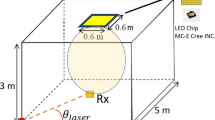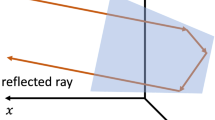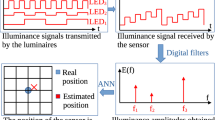Abstract
In this paper, we optimize parameters of indoor visible light localization system based on support vector regression algorithm to achieve higher positioning accuracy. Additionally, some other popular supervised machine learning algorithms such as linear regression, artificial neural networks, and k-nearest neighbors are also implemented. Then, we compare these solutions together to demonstrate the superiority of our approach. This solution is simulated in a hypothetical space of 5 m × 5 m × 3 m. To obtain satisfactory performance, a system of four LED lights and a photodiode are used to transmit and receive optical power, respectively. In the proposed system, the location estimation process is divided into two distinct sub-processes: offline stage and online stage. In the offline stage, data collection and data training are carried out. The results obtained from this stage and the current data in the online stage are the base to determine the current location of the object carrying the photodiode. The simulation results prove that our approach can achieve positioning accuracy of almost 7.4 cm.
Access this chapter
Tax calculation will be finalised at checkout
Purchases are for personal use only
Similar content being viewed by others
References
Vanus, J., Stratil, T., Martinek, R., Bilik, P., Zidek, J.: The possibility of using VLC data transfer in the smart home, vol. 49, no. 25, pp. 176–181. Elsivier (2016). https://doi.org/10.1016/j.ifacol.2016.12.030
Pathak, P.H., Feng, X., Hu, P., Mohapatra, P.: Visible light communication, networking, and sensing: a survey, potential and challenges. IEEE Commun. Surv. Tutorials 17(4), 2047–2077 (2015). https://doi.org/10.1109/comst.2015.2476474
Luo, J., Fan, L., Li, H.: Indoor positioning systems based on visible light communication: state of the art. IEEE Commun. Surv. Tutorials 19(4), 2871–2893 (2017). https://doi.org/10.1109/comst.2017.2743228
Zou, H., Jin, M., Jiang, H., Xie, L., Spanos, C.J.: WinIPS: WiFi-based non-intrusive indoor positioning system with online radio map construction and adaptation. IEEE Trans. Wirel. Commun. 16(12), 8118–8130 (2017). https://doi.org/10.1109/TWC.2017.2757472
Haute, T.V., et al.: Platform for benchmarking of RF-based indoor localization solutions. IEEE Commun. Mag. 53(9), 126–133 (2015). https://doi.org/10.1109/MCOM.2015.7263356
Keskin, M.F., Sezer, A.D., Gezici, S.: Localization via visible light systems. Proc. IEEE 106(6), 1063–1088 (2018). https://doi.org/10.1109/JPROC.2018.2823500
Park, J.K., Woo, T., Kim, M., Kim, J.T.: Hadamard matrix design for a low-cost indoor positioning system in visible light communication. IEEE Photon. J. 9(2), 1–10 (2017). https://doi.org/10.1109/jphot.2017.2667038. Art no. 7801710
Xie, B., Chen, K., Tan, G., Lu, M., Liu, Y., Wu, J., et al.: LIPS: a light intensity-based positioning system for indoor environments. ACM Trans. Sen. Netw. 12, 1–27 (2016)
Nadeem, U., Hassan, N.U., Pasha, M.A., Yuen, C.: Highly accurate 3D wireless indoor positioning system using white LED lights. Electron. Lett. 50, 828–830 (2014)
Jung, S.Y., Hann, S., Park, C.S.: TDOA-based optical wireless indoor localization using LED ceiling lamps. IEEE Trans. Consum. Electron. 57, 1592–1597 (2011)
Smola, A.: Regression estimation with support vector learning machines. Technical report, Technische Universität München (1996)
Zhang, L., Li, Y., Gu, Y., Yang, W.: An efficient machine learning approach for indoor localization. China Commun. 14(11), 141–150 (2017). https://doi.org/10.1109/CC.2017.8233657
Shi, K., Ma, Z., Zhang, R., Hu, W., Chen, H.: Support vector regression based indoor location in IEEE 802.11 environments. Mob. Inf. Syst. 2015, 14 p. (2015). https://doi.org/10.1155/2015/295652. Article ID 295652
Gradim, P., Fonseca, L.N.A., Mohamed, R.E.: On the usage of machine learning techniques to improve position accuracy in visible light positioning systems. In: 2018 11th International Symposium on Communication Systems, Networks & Digital Signal Processing (CSNDSP), Budapest, pp. 1–6 (2018). https://doi.org/10.1109/csndsp.2018.8471773
Saadi, M., Ahmad, T., Zhao, Y., Wuttisttikulkij, L.: An LED based indoor localization system using k-means clustering. In: 2016 15th IEEE International Conference on Machine Learning and Applications (ICMLA), Anaheim, CA, pp. 246–252 (2016). https://doi.org/10.1109/icmla.2016.0048
Shawky, S., El-Shimy, M.A., El-Sahn, Z.A., Rizk, M.R.M., Aly, M.H.: Improved VLC-based indoor positioning system using a regression approach with conventional RSS techniques. In: 2017 13th International Wireless Communications and Mobile Computing Conference (IWCMC), Valencia, pp. 904–909 (2017). https://doi.org/10.1109/iwcmc.2017.7986406
Zhang, X., Duan, J., Fu, Y., Shi, A.: Theoretical accuracy analysis of indoor visible light communication positioning system based on received signal strength indicator. J. Lightwave Technol. 32(21), 4180–4186 (2014). https://doi.org/10.1109/jlt.2014.2349530
Ghassemlooy, Z., Popoola, W., Rajbhandari, S.: Optical Wireless Communications, System and Channel Modeling with MATLAB. CRC Press, Boca Raton (2012). ISBN 9781439851883
Smola, J., Schölkopf, B.: A tutorial on support vector regression. NeuroCOLT2 Technical report Series NC2-TR-1998-030 (1998)
Acknowledgments
This work was supported by Korea Hydro & Nuclear Power company through the project “Nuclear Innovation Center for Haeoleum Alliance”.
Author information
Authors and Affiliations
Corresponding author
Editor information
Editors and Affiliations
Rights and permissions
Copyright information
© 2019 Springer Nature Switzerland AG
About this paper
Cite this paper
Tran, H.Q., Ha, C. (2019). Parameters Optimization for Support Vector Regression Based Indoor Visible Light Localization. In: Huang, DS., Bevilacqua, V., Premaratne, P. (eds) Intelligent Computing Theories and Application. ICIC 2019. Lecture Notes in Computer Science(), vol 11643. Springer, Cham. https://doi.org/10.1007/978-3-030-26763-6_58
Download citation
DOI: https://doi.org/10.1007/978-3-030-26763-6_58
Published:
Publisher Name: Springer, Cham
Print ISBN: 978-3-030-26762-9
Online ISBN: 978-3-030-26763-6
eBook Packages: Computer ScienceComputer Science (R0)




